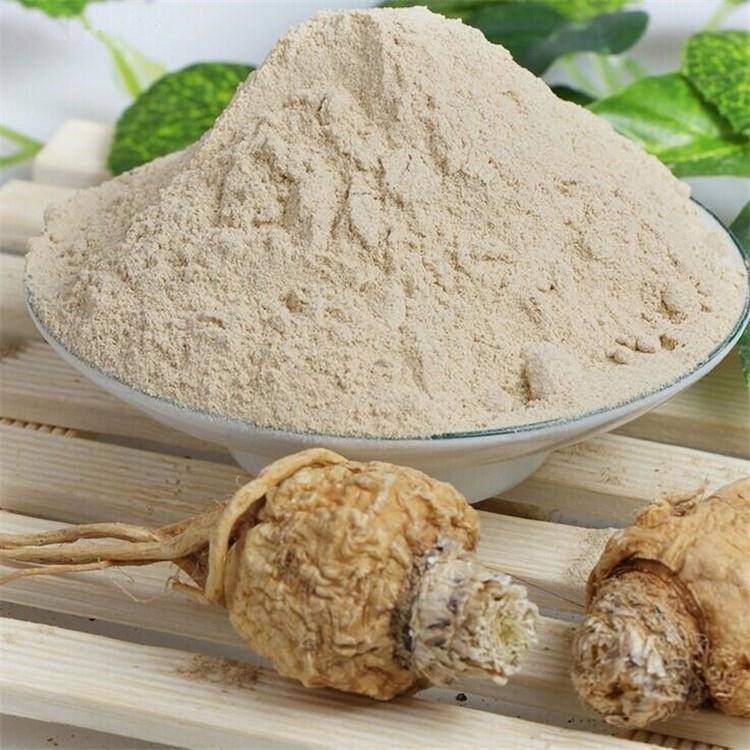Empower Your New Natural Health Formula with Natural Maca Extract
Maca (botanical name: Lepidium meyenii Walp., Spanish: Maca), also known as Peruvian ginseng, is a cruciferous plant native to the Andean highlands of South America. Its fleshy root has a distinctive shape and comes in various colors including purple, cream, or yellow. Since ancient times, residents have regarded it as a natural resource with both medicinal and culinary uses.
Rich in diverse nutrients and bioactive compounds, maca has traditionally been used to enhance physical stamina, alleviate fatigue, support immunity, and regulate bodily functions. Today, with advancements in modern extraction and research technologies, maca extracts have emerged as a highly sought-after functional ingredient in the global health products sector, widely applied in dietary supplements, sports nutrition, and functional foods.
Green Spring Technology remains dedicated to advancing standardized research and raw material development for maca extracts. We are committed to providing enterprise clients with high-purity, scientifically validated maca ingredients, empowering the creation of safe, effective, and differentiated natural health solutions.
1 Natural Multi-Efficacy, Nutrient Empowerment: Maca Extract—Your Source for Health Product Innovation
Derived from the precious plants of Peru's Andes Mountains, maca extract is rich in multiple natural bioactive compounds and essential nutrients, making it an ideal natural ingredient for next-generation health products. Green Spring Technology employs advanced extraction techniques to maximize the preservation of its active value, providing clients with standardized, high-purity maca extract to support the development of more market-competitive functional foods and health products.
Core Active Components and Health Benefits:
· Rich Nutrient Profile: Naturally abundant in protein (12.31%), dietary fiber (32.57%), vitamin C (314.97 mg/kg), and minerals including calcium, iron, zinc, and phosphorus, providing a comprehensive nutritional foundation for products.
· Essential Unsaturated Fatty Acids: Contains significant levels of linoleic acid (38.64%) and linolenic acid (26.46%), supporting cardiovascular health and promoting brain and visual function development—ideal for heart and brain health product development.
· Multiple Natural Bioactive Compounds: Beyond nutrients, it contains bioactive components including alkaloids, glucosinolates, benzyl isothiocyanate, sterols, and polyphenols. These synergistically confer comprehensive health benefits: enhancing physical constitution, improving sleep quality, regulating endocrine function, boosting cellular vitality, and providing antioxidant protection.
Green Spring Technology's Maca Extract utilizes scientifically balanced formulations to preserve the synergistic effects of multiple natural components. This enables your products to excel in enhancing energy, regulating endocrine function, boosting immunity, providing antioxidant protection, and promoting cardiovascular and brain health—meeting consumers' urgent demand for “natural, multi-functional” wellness solutions.
2 Maca Extract: Infusing Health Products with New Vitality Through Scientifically Validated Natural Active Ingredients
Nutrient-rich maca extract has garnered extensive modern research attention for its health benefits. Green Spring Technology is committed to providing high-purity, standardized maca extract raw materials. Grounded in science, we empower businesses to develop more competitive natural health products across multiple domains, including male vitality, female balance, physical performance enhancement, bodily protection, and emotional well-being.
2.1 Male Health & Vitality Products
Maca extract supports enhanced male vitality and improved physiological functions. It is suitable for male nutritional supplements, athletic endurance formulas, and preconception nutritional support products, offering a natural, safe, plant-based ingredient solution for men's health.
2.2 Anti-Fatigue & Sports Nutrition Supplements
This ingredient helps delay physical fatigue and supports post-exercise recovery. It finds broad application in sports nutrition powders, energy bars, endurance supplements, and pre-/post-workout beverages, enhancing athletic performance and physical condition.
2.3 Antioxidant and Immune Support Products
Maca extract offers potent antioxidant properties and immune defense support. It is suitable for daily immune maintenance tablets, antioxidant capsules, senior health formulas, oral liquids, and multi-nutrient supplements, helping strengthen physical constitution and combat oxidative stress.
2.4 Women's Balance and Wellness Products
Maca extract helps regulate multiple physiological indicators, making it suitable for women's comprehensive nutrients, menopause relief formulas, menstrual cycle regulation products, and phytoestrogen supplements. It provides natural nutritional options for women's health throughout their life stages.
2.5 Brain Health & Cognitive Support Products
This ingredient positively supports memory and cognitive function, serving as a core component in key products like brain health capsules for middle-aged and elderly individuals, student memory supplements, cognitive maintenance tablets, and functional beverages for mental performance enhancement.
2.6 Bone Nutrition Supplements
Maca extract helps improve bone density and microstructure health, making it suitable for bone maintenance formulas for middle-aged and elderly individuals, calcium-magnesium-vitamin D complex supplements, joint maintenance products, and women's bone nutrition products.
2.7 Mood Management and Stress Relief Products
Research indicates maca extract helps alleviate tension and emotional fluctuations, making it suitable for stress-relief gummies, mood health capsules, sleep-calming powders, menopausal mood-balancing products, and herbal tranquilizing formulas.
2.8 Male Prostate Maintenance and Protection Products
Maca extract inhibits viral activity and positively supports prostate health, making it suitable for male prostate maintenance capsules, daily protective lozenges, plant-based antiviral supplements, and seasonal maintenance oral solutions.
Green Spring Technology leverages robust scientific research to provide maca extract ingredients with clear composition and defined efficacy, empowering enterprises to achieve differentiated innovation and competitive breakthroughs in functional foods, dietary supplements, sports nutrition, and specific health products.

3 Maca Extract: Empowering Health Product Innovation with Natural Ingredients
Rich in diverse natural nutrients and bioactive compounds, maca stands as a globally recognized functional ingredient in the health product sector. It is currently widely utilized in dietary supplements, sports nutrition, and functional foods.
Green Spring Technology remains committed to maca extract research and application innovation. By establishing rigorous quality standards and a stable raw material supply system, we provide enterprise clients with scientifically validated, high-purity maca extract ingredients of reliable quality. We look forward to collaborating with you to develop safer, more effective, and market-responsive natural health solutions, infusing your products with scientifically grounded natural competitiveness.
For product collaboration and development needs, please contact us at helen@greenspringbio.com or WhatsApp: +86 13649243917 to access technical support and comprehensive product application solutions.
References
[1] Xie R. Special cash crop – maca [J]. Rural News, 2008, 28 (17): 31.
[2] Du P, Shan Y, Sun H, et al. Analysis of the nutritional composition of maca from Yunnan Province [J]. Food Science, 2010, 31 (24): 345–347.
[3] Dini A,Migliuolo G,Rastrelli L,et al.Chemical composition of lepidium meyenii[J].Food Chem,1994,49(4) : 347-349 .
[4]Cicero A F,Bandieri E,Arletti R. Lepidium meyenii Walp.im- proves sexual behaviour in male rats independently from its action on spontaneous locomotor activity[J].J Ethnopharmacol,2001, 75 (2-3) : 225-229 .
[5] Melnikovova I ,Fait T ,Kolarova M ,et al. Effect of Lepidium meyenii Walp.on semen parameters and serum hormone levels in healthy adult men : A double-blind,randomized,placebo-con- trolled pilot study[J].Evidence-Based Complementray and Al- ternative Medicine,2015,2015 ( 1) : 324-369 .
[6] Ding Zhenbin. The effect of maca extract on exercise fatigue and plasma composition [J]. Food Research and Development, 2016, 37 (18): 178-181.
[7] Tenci B,Di C M L,Maresca M,et al.Effects of a water extract of Lepidium meyenii root in different models of persistent pain in rats.[J].Zeitschrift Für Naturforschung C,2017,72( 11 -12) : 449-457 .
[8]Yu M Y,Qin X J ,Shao L D ,et al.Macahydantoins A and B, two new thiohydantoin derivatives from Maca ( Lepidium meye- nii) : structural elucidation and concise synthesis of macahydantoin A[J].Tetrahedron Letters,2017,58 ( 17) ,1684 -1686 .
[9]Yu M Y,Qin X J,Peng X R , et al.Macathiohydantoins B -K, novel thiohydantoin derivatives from Lepidium meyenii[J].Tetra- hedron (2017) ,73 (30) ,4392-4397 .
-
Prev
Green Spring Technology's High-Stability Standardized Feverfew Extract Significantly Enhances Bioavailability
-
Next
Loquat Leaf Extract 10% Corosolic Acid Fuels Innovations in Wellness Formula


 English
English French
French Spanish
Spanish Russian
Russian Korean
Korean Japanese
Japanese




